Unveiling the Real Drivers Behind Your Calendar Chaos
By Kip Jordan, October, 2024
Meetings. Love them or hate them, they're an inescapable part of modern work life. But have you ever stopped to calculate the actual cost of those endless Zoom calls or conference room gatherings? As it turns out, the financial impact of meetings is far more significant than most of us realise. In a recent deep dive into meeting data gathered from the web app Ur Meeting Cost, surprising insights have emerged about what truly drives up the cost of meetings—and it's not just the duration.
The Quest to Quantify Meeting Costs
It all started with a simple question: What factors contribute most to the cost of meetings? To find answers, data was collected from users of Ur Meeting Cost, where individuals input details like the number of attendees, their salary levels, and the duration of meetings to calculate costs.
At first glance, you might assume that longer meetings naturally cost more. After all, time is money, right? But as the data unfolded, a different story emerged—one that challenges common assumptions and sheds light on how organisations can better manage both their time and budgets.
Unveiling the Key Drivers
-
Salary: The Silent Heavyweight
Finding: Salary levels of attendees are the most significant factor influencing meeting costs.
When we think about expensive meetings, we might picture large groups or marathon sessions. However, the data tells us that who is in the meeting matters more than how many or how long. High-salary attendees, especially those at senior or executive levels, disproportionately drive up costs. Even a short meeting can become a budget buster if it includes top-tier executives.
Why is this happening? As anyone can summise, the cost of a meeting is directly tied to the salaries of its participants. High earners, such as executives, command a higher hourly rate. For example, having just one or two executives in a meeting, who can earn ten times more than junior staff, can be equivalent to the cost of an entire team's full day of work. When these high-salary individuals attend meetings, their time translates into significant financial expenditure for the company. The cumulative effect of multiple high-salary attendees can quickly escalate the overall cost.
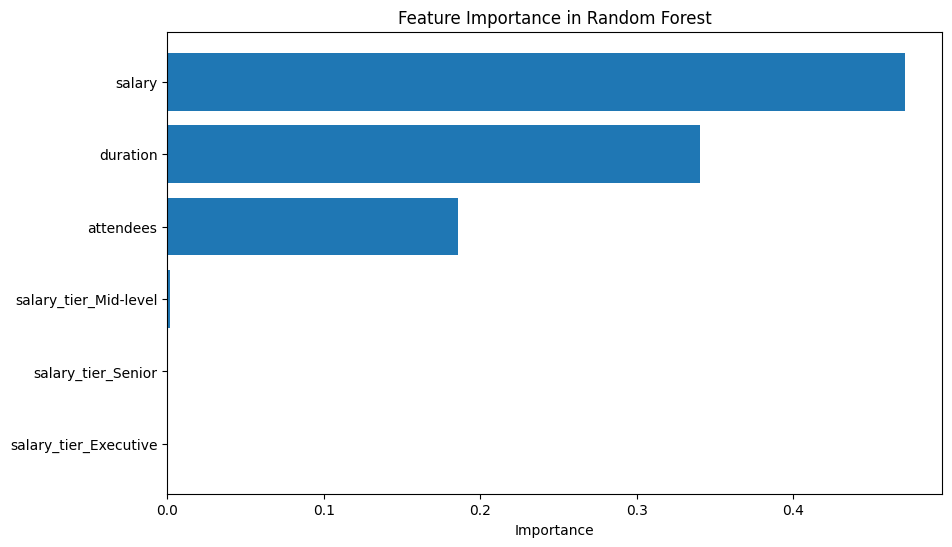
-
Attendees: More Isn't Always Merrier
Finding: The number of attendees does impact costs but is less influential than the salary levels of those attendees.
While it's logical that more people in a meeting equates to higher costs, the effect isn't as pronounced as you might think. It's the combination of many attendees and high salaries that leads to exponential cost increases. A large meeting of junior staff doesn't hit the budget as hard as a small meeting filled with executives.
The interaction effect: The real financial impact becomes evident when high-salary attendees are involved in large groups. This interaction between salary and the number of attendees creates a compounding effect on the total cost.
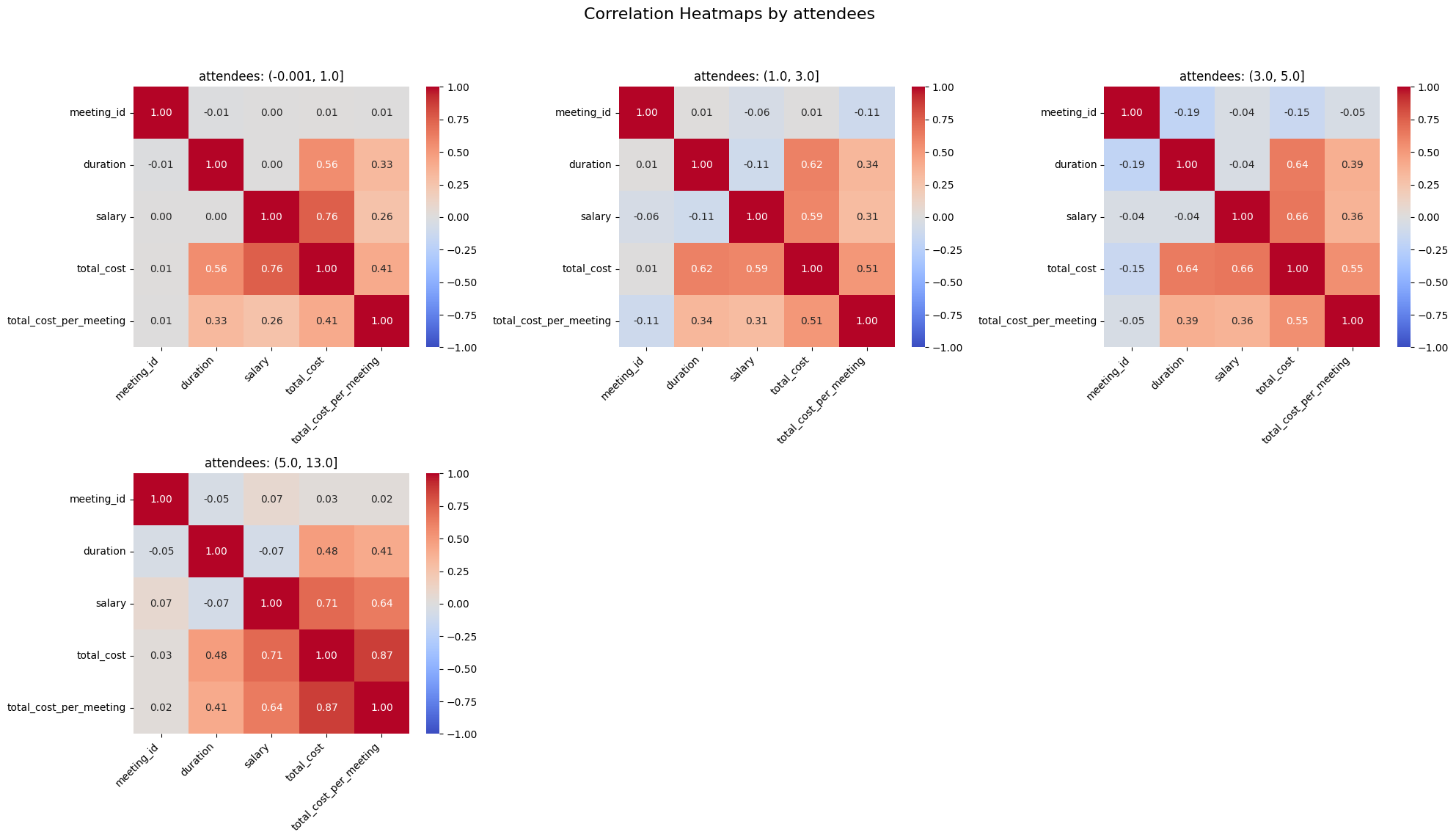
-
Duration: Not the Culprit We Thought
Finding: Meeting length has a weaker correlation with costs compared to salary and attendees.
Contrary to popular belief, longer meetings aren't inherently more expensive. In fact, duration alone doesn't significantly drive up costs unless combined with high-paid attendees. A brief meeting with several executives can cost more than a lengthy session among junior staff.
Implication: Focusing solely on shortening meetings may not yield the cost savings organisations expect. It's more effective to be strategic about who attends these meetings.

Decoding the Data: How We Got Here
To reach these conclusions, various statistical methods were employed. But don't worry—we'll keep the technical jargon to a minimum.
Correlation Studies: Finding Relationships
A correlation study examines how changes in one variable are associated with changes in another. In this case, we looked at how factors like salary, attendees, and duration relate to total meeting costs.
- Strong Correlation: Salary had a strong positive correlation with meeting costs.
- Medium Correlation: Number of attendees showed a moderate correlation.
- Weak Correlation: Duration had the weakest correlation among the three.
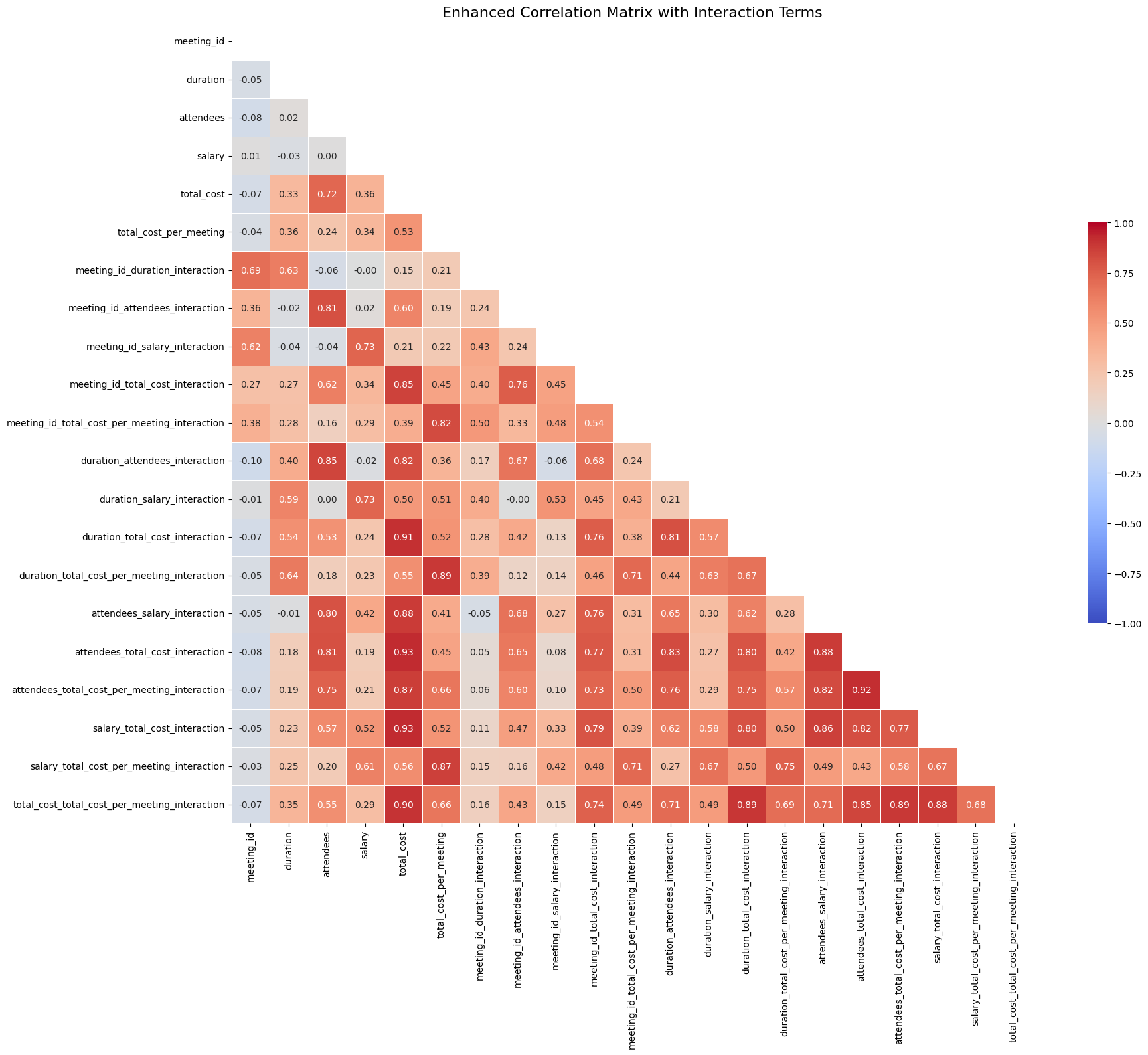
Random Forest Models: Predicting Outcomes
Random forest is a type of machine learning algorithm that's great for handling complex data with lots of variables. Think of it as a team of decision-makers (trees) that work together (forest) to make better predictions.
- How it works: Each "tree" in the forest makes a prediction based on a subset of the data. The forest combines these predictions to improve accuracy.
- What we found: Salary consistently emerged as the most important factor in predicting meeting costs, reinforcing our findings from the correlation studies.
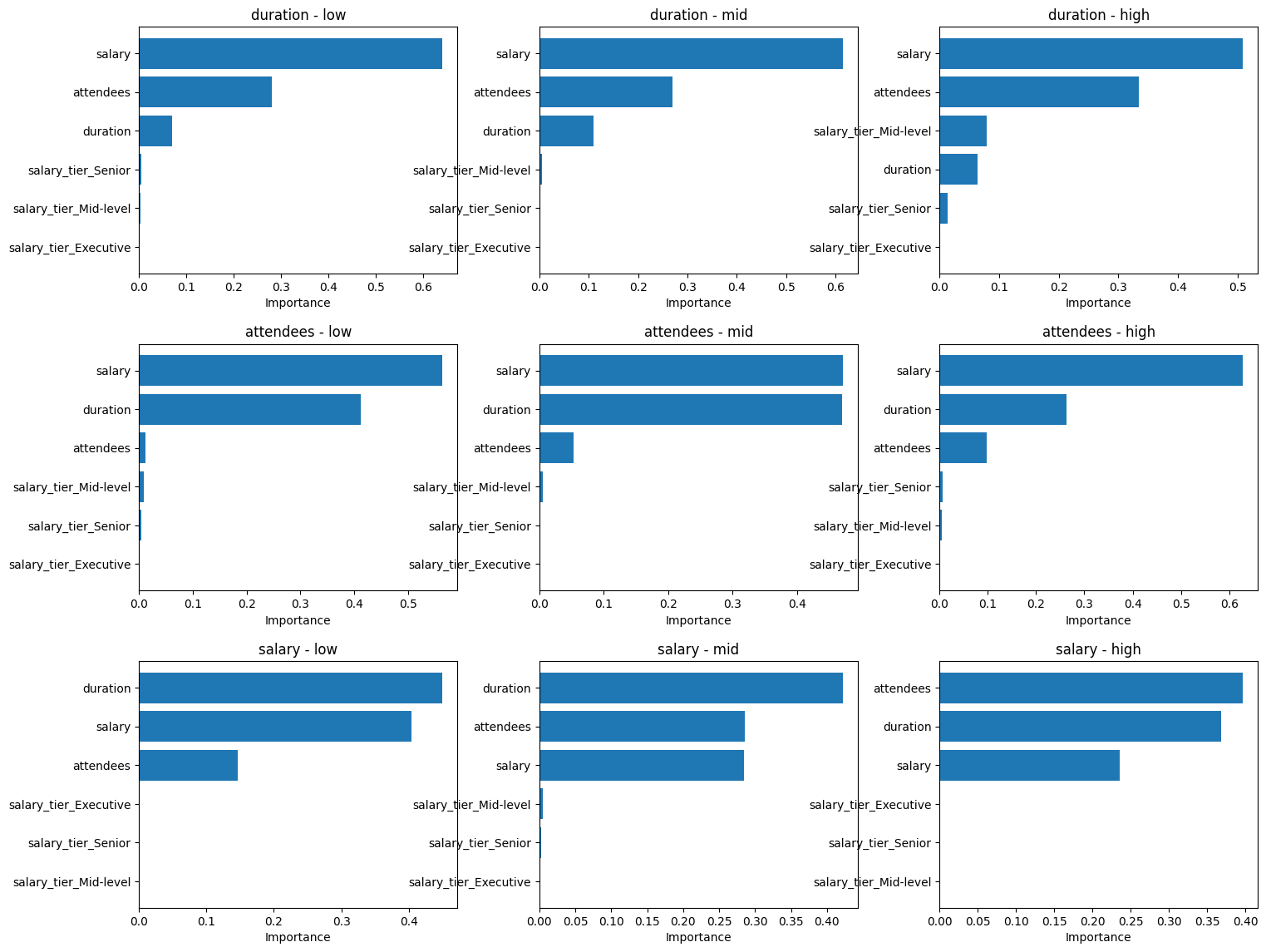
Interaction Terms: The Power of Combinations
An interaction term in statistical modelling captures the effect of two variables working together. For example, the combined impact of high salary and many attendees on meeting cost.
Why it matters: By including interaction terms, we can see how variables amplify each other's effects, leading to more accurate and insightful models.
Bringing It All Together: What Does This Mean for You?
The data paints a clear picture: To manage meeting costs effectively, focus on who's in the room rather than how long you're there. However, it's crucial to remember that while we can quantify the costs of meetings, the return on investment (ROI) remains elusive. The insights here are not about how much you need to spend to make money, but rather about being thoughtful with the resources you allocate to meetings.
Actionable Insights:
- Be Selective with High-Salary Attendees:
- Before inviting top executives or highly paid specialists, consider whether their presence is essential.
- Can the meeting's goals be achieved without them, or with a brief consultation instead?
- Could this meeting have been an email?
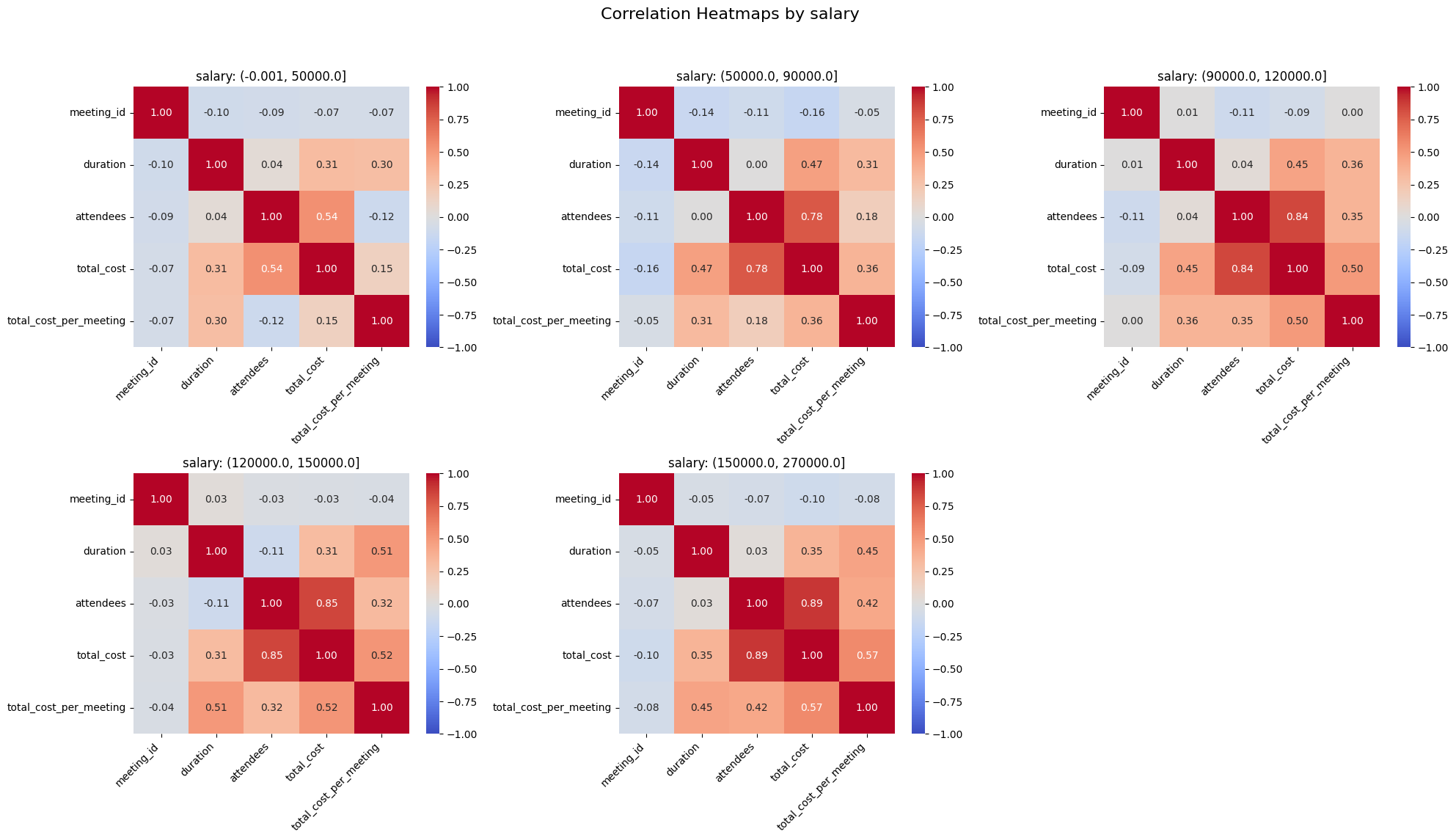
This heatmap shows the correlation between meeting costs and different salary tiers, highlighting how high-salary attendees significantly drive up costs.
- Optimise Attendee Lists:
- Limit meetings to individuals whose input is critical.
- Avoid the "more the merrier" approach, which can unnecessarily inflate costs.
- Rethink Meeting Length Priorities:
- While time management is important, reducing the number of high-cost attendees has a greater financial impact than simply shortening meetings.
- Focus on efficiency and purpose rather than just duration.
- Leverage Technology:
- Use collaborative tools and asynchronous communication to involve stakeholders without requiring their presence in every meeting.
- Consider recording meetings for those who need information but don't need to participate live.
Challenging Common Assumptions
This analysis challenges the notion that longer meetings are the main drain on resources. Instead, it's the hidden cost of attendees' time—especially those with high salaries—that silently eats away at budgets. Yet, it's important to acknowledge that the true value of a meeting isn't always reflected in its cost. The potential benefits, such as strategic decisions or innovative ideas, can be significant but are often intangible.
By shifting the focus to attendee selection and understanding the compounding effects of salary and group size, organisations can make more informed decisions that benefit both productivity and the bottom line.
The Bigger Picture: Cultural Change and Productivity
Beyond the financials, rethinking meeting structures can lead to a more productive and engaged workforce.
- Empower Decision-Making: Smaller, focused meetings can lead to quicker decisions and less time wasted.
- Enhance Employee Satisfaction: Reducing unnecessary meetings frees up time for employees to focus on meaningful work.
- Promote Efficient Communication: Encouraging concise and purposeful meetings sets a cultural standard that values everyone's time.
Looking Ahead: The Future of Meetings
As remote work and digital collaboration continue to evolve, so too will our approach to meetings. This analysis serves as a reminder that effective meeting management isn't just about clock-watching—it's about strategic planning and valuing the contributions of each participant. While we can measure the cost inputs, the outputs in terms of value and innovation are less tangible but equally important.
Organisations that adapt by being mindful of attendee composition and leveraging technology will not only save money but also foster a more efficient and satisfied workforce.
About Ur Meeting Cost:
Ur Meeting Cost is a web application designed to help individuals and organisations calculate the real-time cost of their meetings. By inputting details like attendee salaries, meeting duration, and group size, users can gain insights into the financial impact of their meetings.
Final Thoughts
Meetings are an integral part of collaboration and decision-making. By understanding the true drivers of meeting costs, we can make smarter choices that respect both our time and resources. So the next time you're scheduling a meeting, take a moment to consider not just how long it will be, but who really needs to be there.
Downloadable Resources
Detailed Analysis
Click on the links below to view the detailed analysis of the correlation and regression analyses performed in Visual Studio Code using Jupyter Notebook and Python!